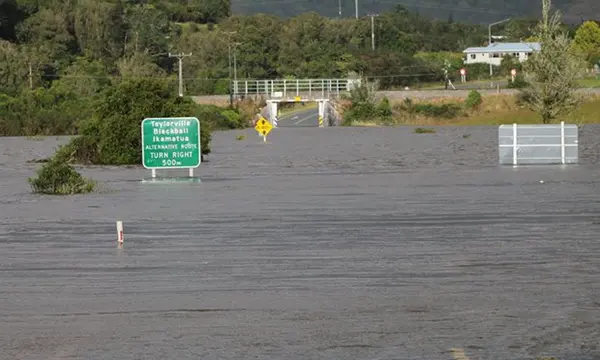A flooded highway in New Zealand. Photo: The Guardian
A powerful "weather bomb"has hit New Zealand, cutting off rural towns, flooding major roads and dumping snow on to bare alpine ski fields at what should be the height of the southern hemisphere summer.
The significant low edged over the South Island late on Thursday afternoon, causing landslips and snow, and went on to lash the country throughout the weekend.
Auckland in the North Island suffered major power outages, while rivers on the west coast of the South Island rose rapidly in a matter of hours, lapping at roadsides and carrying large debris, including trees washed down from the southern alps.
Warnings and road closures are still in place in the central and southern parts of the South Island and the Southland farming town of Waikaia remains cut off, with soaked pastures threatening farm infrastructure and farmers urgently evacuating livestock to higher ground.
A landslip also buried famous Sylvia Flats hot pools, and residents of Dunedin reported having to burn their fences to stay warm, after being caught off guard by the unseasonal weather.
In Greymouth, which was hit by heavy rainfall, residents made the best of a wet situation.
The MetService said "extreme"weather events such as the weather bomb were becoming increasingly common in New Zealand, which already had challenging weather patterns because of its close proximity to Antarctica and its narrow, alpine environment.
"This weather bomb was caused by a burst of really hot air coming out of Australia and forming a low when it moved into the Tasman sea, and then picking up moisture and increasing in intensity," said Mads Naeraa-Spiers, a forecaster for the MetService.
"It brought heavy rain, gale-force winds and cold-wet southerlies. Cardrona snow field looked like it should the middle of winter, not summer."
Naerra-Spiers said rapid floods on the west coast were an ongoing concern, while high winds had flipped cars and caused "flying trampolines".
"New Zealand is prone to extreme and rapid variations in temperature and it can get really cold regardless of the season because of our proximity to Antarctica. That said while it was snowing in the South Island some parts of the North Island wererecording temperatures in the high 20s."
On Monday afternoon the Met Service issued another severe weather warning for most parts of the South Island, expected to arrive by Tuesday afternoon and bring gale-force winds and heavy rains.
Naerra-Spiers said the unseasonable weather was set to continue for at least another couple of weeks, and warm, stable weather was not expected until February and March.
"We seem to be stuck somewhat in this pattern of systems coming out of Australia, we are not out of the woods yet," he said. "New Zealand is an extreme place weather-wise but we do seem to be experiencing a lot more severe events and they do have quite a heavy impact on the country."
(SOUTH CHINA MORNING POST)
 简体中文
简体中文

